IAC News
IAC News No.101, March 2021
Japan Society of Civil Engineers International Activities Center March 1, 2021 IAC News No.101
TC21 Webinar:
“Transdisciplinary Approach (TDA) for Building Societal Resilience to Disasters Amid the COVID-19 Pandemic”
TC21, the 21st Technical Committee of the Asian Civil Engineering Coordinating Council (ACECC), has been sharing and practicing the concept of a transdisciplinary approach (TDA) with the aim of building societal resilience to disasters through a transdisciplinary approach (TDA). This is a report on the webinar held in parallel with the ACECC Executive Committee Meeting in October 2020.
Disaster Mitigation Measures amid the COVID-19 Pandemic
During the 2020 Kyushu floods, which caused great damage along the Kumagawa River, the novel coronavirus (COVID-19) had a significant impact on evacuation activities. Although disaster mitigation measures are becoming an issue in various parts of the world as social distance protocols must be maintained due to the global COVID-19 pandemic, the sharing of information on a global scale is limited. This webinar (Table 1) was held to facilitate the sharing of such information.
Table 1: Webinar Program
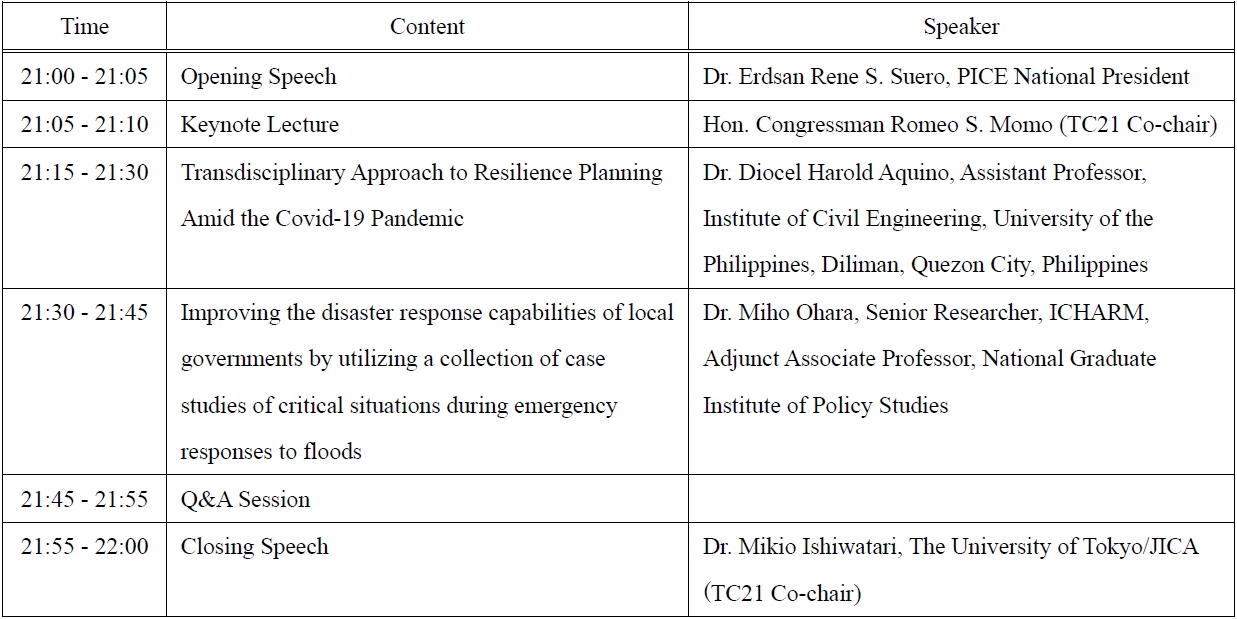
Civil Engineers’ Responsibilities and Transdisciplinary Approach (TDA)
PICE President Dr. Erdsan Rene S. Suero gave an opening speech where he introduced the idea that the responsibility of civil engineers to build societal resilience to disasters remains the same even amid the COVID-19 pandemic, and for this reason, TC21 is being used to promote case studies and popularize the concept of TDA. He then went on to say that decision-making based on scientific knowledge by way of TDA is very essential.
Next, TC21 Co-chair Romeo S. Momo (Congressman in the House of Representatives, Philippines Congress) gave a keynote lecture. Mr. Momo stated that in the Philippines, COVID-19 is having a serious impact on the lives of those who live there as well as the country’s economic activities, and that the construction industry has contributed significantly to the country's development under the government’s flagship “Build, Build, Build” infrastructure development program, however, efforts to mitigate the negative impact of COVID-19 are required. He also emphasized the importance of TDA in collaboration with private companies, academia, citizens, and NGOs, as well as governments.
TDA amid the COVID-19 Pandemic
Under the theme of “Transdisciplinary Approach to Resilience Planning Amid the Covid-19 Pandemic,” Dr. Diocel Harold Aquino of the University of the Philippines gave a lecture on the research of disaster-related risk and earthquake vulnerability of structures in Metro Manila, which is being implemented under movement restrictions. In Dr. Aquino’s lecture, he introduced the fact that digital technologies such as online information, aerial photography, and online meetings are being used to avoid coming together in closed spaces to maintain social distancing protocols. Meanwhile, he stated that while local residents verifying information is important to improve its reliability, it is difficult to convey one’s exact intentions when communicating through a means that is not face-to-face. Therefore, to solve this problem, civil engineers and social scientists are currently working together on an initiative across fields to extract what the residents truly mean.
Examples of Critical Situations and Lessons Learned
Next, Dr. Ohara of the International Centre for Water Hazard and Risk Management (ICHARM) gave a lecture entitled “Enhancing Preparedness of Local Governments by Using a Collection of Critical Situations during Flood Emergency Response under COVID-19.” This collection of case studies was published by ICHARM to improve the disaster response capabilities of departments in charge of disaster mitigation at local governments. Dr. Ohara defined examples in which staff are “troubled, act hastily, confused, hesitate, and worry” as “critical situations during emergency responses to flooding,” introduced lessons learned from such situations with examples, and explained that a separate volume highlighting the response amid the COVID-19 pandemic was also released. Dr. Ohara also explained that this initiative is the outcome of TDA, such as cooperation between research institutes and local governments and bringing together knowledge on safety engineering and disaster mitigation.
Role of ACECC TC21
In the Q&A session, in response to a participant’s question about what Japan and the Philippines can share with each other, both Dr. Aquino and Dr. Ohara answered that both countries have the fact that they experience many natural disasters in common, and that sharing case studies and lessons learned could contribute to building a stronger society in regards to disaster mitigation.
As the closing speech of this webinar, TC21 Co-Chair Dr. Ishiwatari said that it is important to build societal resilience to disasters based on scientific knowledge and to learn lessons from each country. He also stated that it is the role of TC21 to investigate, analyze, and share case studies from around the world. He went on to request continued support for the efforts of TC21 and closed by thanking the stakeholders and participants of this webinar including PICE.
Conclusion
This year, the efforts of TC21 were also severely restricted due to the impact of COVID-19. On this occasion, by using the digital technology of holding a webinar, it was possible for people and regions that normally have difficulty in participating in such seminars to join in. We were able to discuss the popularizing of the concept of TDA promoted by TC21 and the new theme of building societal resilience to disasters in this age of a “new normal.”
TC21’s achievements are viewed on the following websites: http://www.acecc-world.org/TC21/
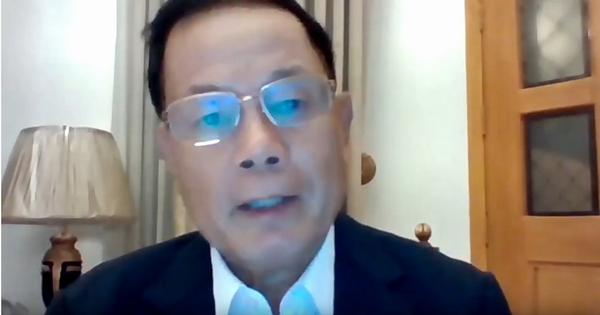
Keynote Lecture by TC21 Co-chair Romeo S. Momo
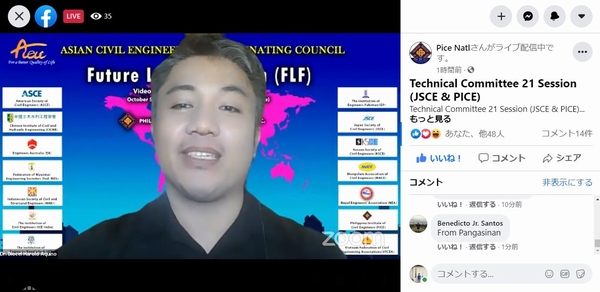
Streamed Live on Facebook for Those Who Could Not Participate
in the Zoom Webinar Facebook
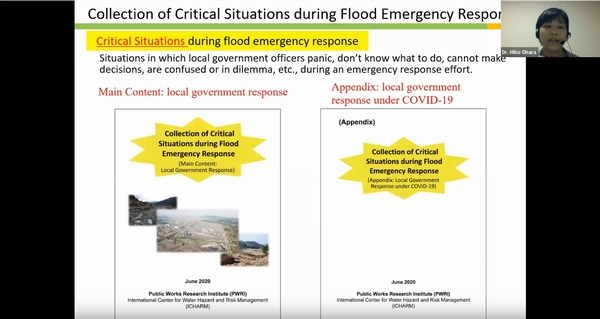
Dr. Ohara Introduces a Collection of Critical Situations
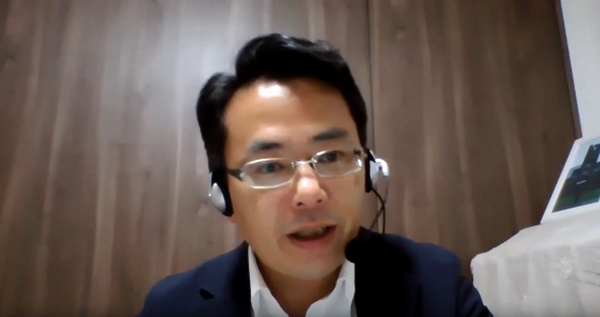
Closing Speech by TC21 Co-chair Dr. Ishiwatari
【Reported by Yoshihiro Katsuhama, Secretariat,
ACECC TC21 Support Committee (Nippon Koei Co. Ltd.)】
Structure to Bridge Creation Hubs during the Pandemic
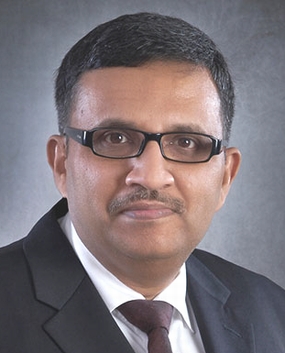
A.F.M. Saiful Amin
(Chair, Bangladesh Group of IABSE,
Professor of Civil Engineering,
Bangladesh University of
Engineering and Technology)
COVID-19 pandemic forced the world to follow social-distancing guidelines, which made it difficult to collaborate and progress overall. However, from our experience of past pandemics, we know that the world not only successfully preserved civilization and its creators during such challenges, but also moved forward. In 1889, Paris experienced the Asiatic flu pandemic, and yet the Eiffel Tower was built and inaugurated in the same year. The flu reached British India in 1890, just as planning for the Hardinge Bridge over the Padma had started, but it didn’t deter the engineers to stop their work. Then in 1918, despite the Spanish Flu, the Seikan Tunnel in Japan was conceived. This just proves that even in the past, pandemics couldn’t act as long-term deterrents. Despite the current social-distancing impositions, small, cohesive entities have bonded strongly and offered sustainable solutions. We have also noticed that innovations in information technology is progressing fast, and the fourth industrial revolution (4IR) is advancing more quickly than ever. Nevertheless, the importance of safe and reliable infrastructures cannot be replaced. This is where, IABSE with its worldwide members plays a pivotal role. IABSE not only connects engineers worldwide but also provides a collaborative platform for discussions, and advancement of the profession.
On August 26‐27, 2020, the Bangladesh Group of IABSE co-organized an online event with the Japan Society of Civil Engineers (JSCE) at the International Conference on Advances in Bridge Engineering-IV: Definitive Outcomes for the People. 700 participants from six continents with up to 19 hours of time difference joined the virtual event, and presented in real-time, despite the pandemic. The quality assurance in engineering education symposium, co-hosted within the virtual conference organized by us, exposed the importance of bridge engineering to other engineering disciplines‐and “bridge” emerged as a metaphor! The strong support from fourteen international, and national entities was vital for this event. In true alignment with IABSE’s mission, we achieved in providing a global platform for information exchange. Over the past 15 years, our National Group has organized several international events jointly with JSCE. By publicly celebrating the centenary of the Hardinge Bridge in 2015, we communicated the importance of bridge engineering to the common people—a milestone achievement. This pandemic-time success is well founded on our past efforts.
With the rise of Asian economies, improved access through land-transportation infrastructure is a must, but is often a challenge specially in Bangladesh-which is crisscrossed by hundreds of rivers, resulting in soft soil and ground dynamics. Building enough bridges to create a fixed network of surface roads and rail is necessary to meet not only our steadily growing domestic needs but also to meet emerging regional surface-connectivity demands. National and international stakeholders having solidarity can together bridge this gap by stimulating creativity. Young generations of engineers can also strive to develop new capacities, with the support of experienced structural engineers to execute complex designs, constructions and maintenances. IABSE Fellows’-Young Engineers Program does exactly that. The Bangladesh Group of IABSE for the last 15 years has strived to spread IABSE’s message and bring together national as well as international experts towards to advancement of the profession. We shall keep working towards this goal, and hopefully together we shall soon emerge in a post-pandemic world in 2021!
Source: Structural Engineering International, Volume 31, 2021, Issue 1
(https://doi.org/10.1080/10168664.2021.1863652)
【Reported by A.F.M. Saiful Amin, Chair, Bangladesh Group of IABSE,
Professor of Civil Engineering,Bangladesh University of Engineering and Technology】
Updates
- Road Asset Management Seminar for International Students in 2021 (1st - 5th March)
https://committees.jsce.or.jp/opcet_sip/node/23 - JSCE-PII-MCA Joint Seminar (Online) ~Recent Advances and Practices of Concrete Materials, Structures, and Constructions in Indonesia, Japan, and Mongolia~ (2nd - 3rd March)
https://www.jsce-int.org/node/704
*Registration: https://tinyurl.com/4kwakueo - 1st JSCE Concrete Committee Webinar "Frontiers of Concrete Technology"
Webinar Title: Use of FRP Composites for Sustainable Concrete Structures (16th April)
https://www.jsce-int.org/node/705 - ASCE Lifeline Conference 2021 2022
https://samueli.ucla.edu/lifelines2021/ - The Second International Conference on Press-in Engineering (ICPE) 2021, Kochi: https://icpe-ipa.org/
- IAC YouTube Channel
https://youtube.com/channel/UCGIs6DHrzX_cGD-mHUrRlkA - 9th International Conference on Experimental Vibration Analysis for Civil Engineering Structures (EVACES2021):https://ec-intl.co.jp/evaces2021/
- 9th Civil Engineering Conference in the Asian Region (CECAR9) in Goa, India(Sept 21, 22, and 23, 2022): http://www.cecar9.com/
- jhappy - JICA’s Grant Aid Cooperation -
Facebook: https://www.facebook.com/jhappy20161110/
Twitter: https://twitter.com/jhappy_official - The International Infrastructure Archives
– A Compilation of Japan’s Greatest Projects in Transfer of Civil Engineering Technology in Service –
http://www.jsce.or.jp/e/archive/ - IAC “News Pick Up!!” on the JSCE Japanese website
https://committees.jsce.or.jp/kokusai/iac_dayori_2021 - Summary of featured articles in JSCE Magazine Vol. 106, No.3, March 2021
http://www.jsce-int.org/pub/magazine - Journal of JSCE
https://www.jstage.jst.go.jp/browse/journalofjsce
IAC News Subscription
The IAC News is one of the communication tools to share information and ideas with the members. We would like to invite you, your friends and colleagues to join the communication and to subscribe the IAC News. Please register online: (http://www.jsce-int.org/node/150). We look forward to meeting you.
